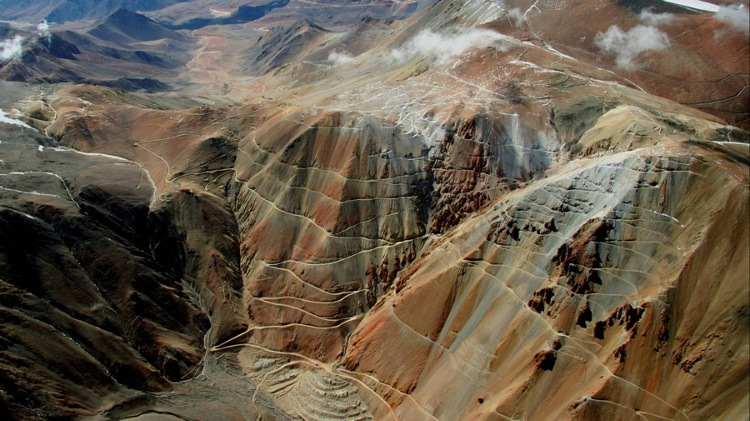A BHP train carries iron ore from its Newman operation in Western Australia. This week one of its trains was forcibly derailed after "running away" en route to a shipping hub. Courtesy of BHP Billiton
Welcome back to your weekly mining news recap. At the end of the week we’ll catch you up on the mining news from CIM Magazine and elsewhere that you may have missed. In this week’s headlines: small modular nuclear reactors generate controversy, Canada’s spy agency keeps tabs on pipeline protesters and we look back at the contributions of Canadian miners in the First and Second World Wars.
*****
Barrick Gold is rumoured to be in talks with Newmont Mining to combine the companies’ Nevada gold operations. The two companies had previously considered this union in 2014. The news of Barrick’s high-profile merger with Randgold, however, brings new management to the bargaining table and has revived interest in the talks. The combination of Barrick and Newmont’s Nevada assets would have produced an estimated 4.1 million ounces of gold in 2017, and could generate up to US$300 million per year.
Mentorship has proven to be a popular method for companies to try and bridge the gender gap in the mining workforce, but critics believe much more needs to be done to encourage the retention of more women and minority employees. While mentorship can provide high level connections and advice for inexperienced employees, it does little to change a company’s prevailing culture, which might not be accomodating for those with little representation in the industry. Part of our We Are Mining series.
Ecuador is facing a lawsuit, brought by the local Cotacachi government, alleging it gave mining companies permission to operate in a protected forest without local consultation, Reuters reported. A spokesperson for the Cotacachi government said the Ecuadorian government has turned 70 per cent of the forest into mining concessions without a single consultation. Ecuador’s constitution allows the state to extract minerals regardless of who the land belongs to, but they also must perform consultations with local communities as well. In two similar cases this year, the courts ruled with the local communities against the government, halting activities in the areas.
The use of battery electric vehicles (BEV) at mine sites is becoming more common as companies work on lowering the emissions generated by their operations. The Global Mining Guidelines Group issued the second edition of its standards guideline for the use of BEVs underground, with more than 100 experts contributing. The guideline, expanding on the first edition from April 2017, cover rules for emergency response, training for operators maintenance and more.
NexGen Energy released an updated feasibility study for its flagship Arrow uranium deposit in Saskatchewan, revealing that the potential of the site is much larger than previously thought. According to the new study, Arrow saw a 43 per cent increase in its indicated mineral resources and a 79 per cent increase of its average annual grade. The value of the property also increased to $3.7 billion, up from $3.49 billion in 2017.
The Canadian Security and Intelligence Service (CSIS) has been keeping track of Indigenous and grassroots protesters of the Trans Mountain pipeline expansion, the Globe and Mail reported. A previously top-secret CSIS brief revealed that the government’s purchase of the pipeline was seen as a “betrayal” by many of the protestors. Protesters said they wonder why CSIS is paying attention to them, as demonstrations have been peaceful and the organization is not allowed to probe lawful protest and dissent.
A BHP train carrying iron ore exports was forcibly derailed after “running away” on its route to a shipping hub, Reuters reported. The company said its current iron reserves would not be enough to cover the disruption caused by the train’s derailment and that it would be in contact with its customers about its contractual obligations. An investigation into the derailment is currently underway, and BHP says it expects rail operations to resume in about a week.
The federal government’s small modular nuclear reactor “roadmap” has garnered mixed reactions, as nuclear supporters and critics argue whether the technology would be good for the country. Supports say it would be an inexpensive and eco-friendly way to supply electrical power to remote communities and mining operations off the local power grids. Opponents say the reactors will be subject to less public and environmental oversight due to the small size of the reactors.
To commemorate Remembrance Day on Sunday, we’ve shared on our homepage a collection of stories that remember the Canadian miners and CIM members who fought in the First and Second World Wars, and the importance of some mines to war efforts. A new section in the monthly CIM Bulletin offered direct correspondence and comfort to CIM members fighting in the trenches during the first World War. Canadian mining corps were a crucial factor in the mining operations taking place at the Rock of Gibraltar, an important strategic position for protecting the British from the Germans in the Second World War. The fighting conditions in the First World War were notoriously dreadful, but mining crews digging secret tunnels through enemy lines experienced their own brand of hardship as well. Lastly, the story of Bell Island – the tiny island in Newfoundland that was home to an iron ore operation that came under attack by German U-Boats in 1942.



